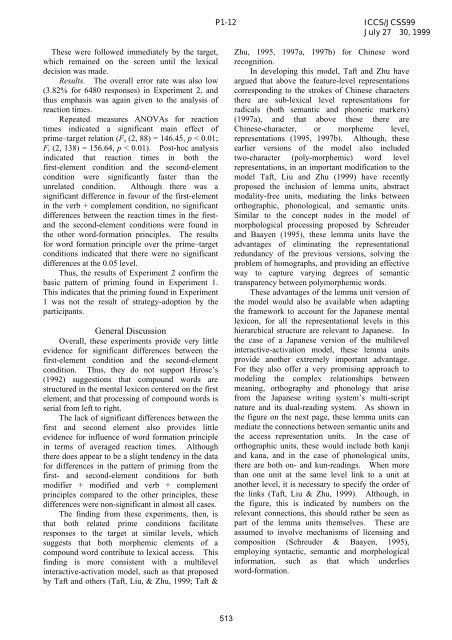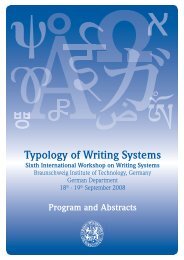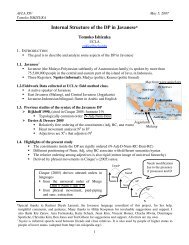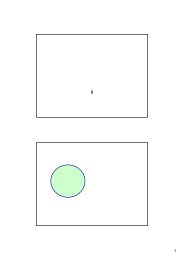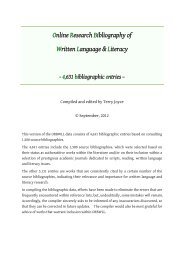A Priming Paradigm Study Terry Joyce, University of Tsukuba
A Priming Paradigm Study Terry Joyce, University of Tsukuba
A Priming Paradigm Study Terry Joyce, University of Tsukuba
You also want an ePaper? Increase the reach of your titles
YUMPU automatically turns print PDFs into web optimized ePapers that Google loves.
P1-12 ICCS/JCSS99<br />
July 2730, 1999<br />
These were followed immediately by the target,<br />
which remained on the screen until the lexical<br />
decision was made.<br />
Results. The overall error rate was also low<br />
(3.82% for 6480 responses) in Experiment 2, and<br />
thus emphasis was again given to the analysis <strong>of</strong><br />
reaction times.<br />
Repeated measures ANOVAs for reaction<br />
times indicated a significant main effect <strong>of</strong><br />
prime–target relation (F s (2, 88) = 146.45, p < 0.01;<br />
F i (2, 138) = 156.64, p < 0.01). Post-hoc analysis<br />
indicated that reaction times in both the<br />
first-element condition and the second-element<br />
condition were significantly faster than the<br />
unrelated condition. Although there was a<br />
significant difference in favour <strong>of</strong> the first-element<br />
in the verb + complement condition, no significant<br />
differences between the reaction times in the firstand<br />
the second-element conditions were found in<br />
the other word-formation principles. The results<br />
for word formation principle over the prime–target<br />
conditions indicated that there were no significant<br />
differences at the 0.05 level.<br />
Thus, the results <strong>of</strong> Experiment 2 confirm the<br />
basic pattern <strong>of</strong> priming found in Experiment 1.<br />
This indicates that the priming found in Experiment<br />
1 was not the result <strong>of</strong> strategy-adoption by the<br />
participants.<br />
General Discussion<br />
Overall, these experiments provide very little<br />
evidence for significant differences between the<br />
first-element condition and the second-element<br />
condition. Thus, they do not support Hirose’s<br />
(1992) suggestions that compound words are<br />
structured in the mental lexicon centered on the first<br />
element, and that processing <strong>of</strong> compound words is<br />
serial from left to right.<br />
The lack <strong>of</strong> significant differences between the<br />
first and second element also provides little<br />
evidence for influence <strong>of</strong> word formation principle<br />
in terms <strong>of</strong> averaged reaction times. Although<br />
there does appear to be a slight tendency in the data<br />
for differences in the pattern <strong>of</strong> priming from the<br />
first- and second-element conditions for both<br />
modifier + modified and verb + complement<br />
principles compared to the other principles, these<br />
differences were non-significant in almost all cases.<br />
The finding from these experiments, then, is<br />
that both related prime conditions facilitate<br />
responses to the target at similar levels, which<br />
suggests that both morphemic elements <strong>of</strong> a<br />
compound word contribute to lexical access. This<br />
finding is more consistent with a multilevel<br />
interactive-activation model, such as that proposed<br />
by Taft and others (Taft, Liu, & Zhu, 1999; Taft &<br />
Zhu, 1995, 1997a, 1997b) for Chinese word<br />
recognition.<br />
In developing this model, Taft and Zhu have<br />
argued that above the feature-level representations<br />
corresponding to the strokes <strong>of</strong> Chinese characters<br />
there are sub-lexical level representations for<br />
radicals (both semantic and phonetic markers)<br />
(1997a), and that above these there are<br />
Chinese-character, or morpheme level,<br />
representations (1995, 1997b). Although, these<br />
earlier versions <strong>of</strong> the model also included<br />
two-character (poly-morphemic) word level<br />
representations, in an important modification to the<br />
model Taft, Liu and Zhu (1999) have recently<br />
proposed the inclusion <strong>of</strong> lemma units, abstract<br />
modality-free units, mediating the links between<br />
orthographic, phonological, and semantic units.<br />
Similar to the concept nodes in the model <strong>of</strong><br />
morphological processing proposed by Schreuder<br />
and Baayen (1995), these lemma units have the<br />
advantages <strong>of</strong> eliminating the representational<br />
redundancy <strong>of</strong> the previous versions, solving the<br />
problem <strong>of</strong> homographs, and providing an effective<br />
way to capture varying degrees <strong>of</strong> semantic<br />
transparency between polymorphemic words.<br />
These advantages <strong>of</strong> the lemma unit version <strong>of</strong><br />
the model would also be available when adapting<br />
the framework to account for the Japanese mental<br />
lexicon, for all the representational levels in this<br />
hierarchical structure are relevant to Japanese. In<br />
the case <strong>of</strong> a Japanese version <strong>of</strong> the multilevel<br />
interactive-activation model, these lemma units<br />
provide another extremely important advantage.<br />
For they also <strong>of</strong>fer a very promising approach to<br />
modeling the complex relationships between<br />
meaning, orthography and phonology that arise<br />
from the Japanese writing system’s multi-script<br />
nature and its dual-reading system. As shown in<br />
the figure on the next page, these lemma units can<br />
mediate the connections between semantic units and<br />
the access representation units. In the case <strong>of</strong><br />
orthographic units, these would include both kanji<br />
and kana, and in the case <strong>of</strong> phonological units,<br />
there are both on- and kun-readings. When more<br />
than one unit at the same level link to a unit at<br />
another level, it is necessary to specify the order <strong>of</strong><br />
the links (Taft, Liu & Zhu, 1999). Although, in<br />
the figure, this is indicated by numbers on the<br />
relevant connections, this should rather be seen as<br />
part <strong>of</strong> the lemma units themselves. These are<br />
assumed to involve mechanisms <strong>of</strong> licensing and<br />
composition (Schreuder & Baayen, 1995),<br />
employing syntactic, semantic and morphological<br />
information, such as that which underlies<br />
word-formation.<br />
513


